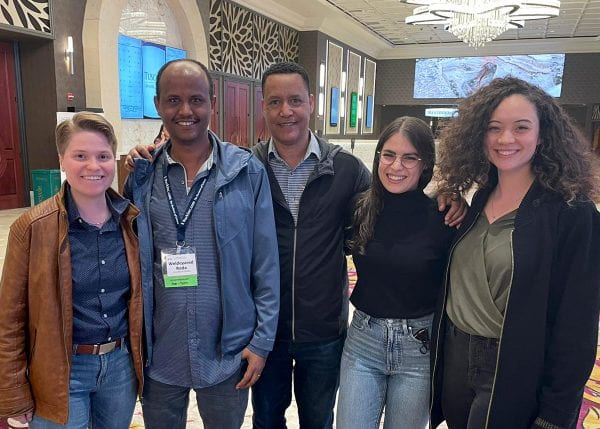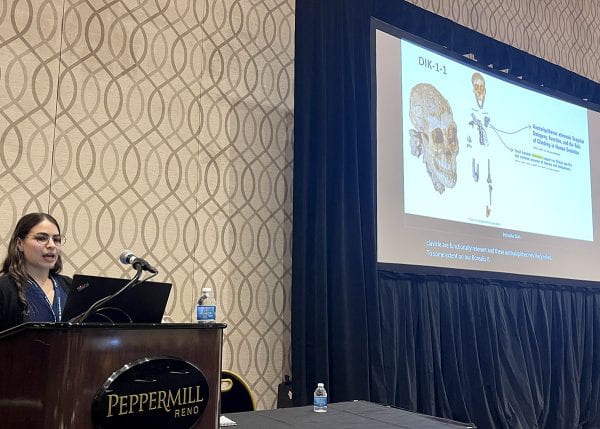The Alemseged team attended the 92nd Annual Meeting of American Association of Biological Anthropologists (AABA) in Reno, Nevada to present their on-going work.

The Alemseged Lab met up at the 2023 AABA conference: Laura, Yared, Zeray, Hannah, and Maddie.
During the special symposium titled “A Session to Honor the Legacy of Bill Kimbel”, Zeray presented a poster covering many of the issues found in his recent review paper in Nature. From Zeray, “I presented on the status of the genus Australopithecus which was named in 1925 based on the Taung Child by Raymond Dart. Decades of field work and the application of novel investigation methods have dramatically improved our knowledge of Australopithecus. The new emerging picture suggests that it was a habitual biped, practiced arboreality, consumed animal resources using rudimentary stone tools, and possessed incipient childhood. The genus, whose ancestor remains elusive, was represented by Australopithecus afarensis from ~ 4.2 to 2.9 Ma, which gave rise to A. platyops and A. africanus before 3 Ma and to Paranthropus, Homo and A. garhi after 3 Ma.”

Zeray reviewed the variation, geographic distribution, and temporal relationships of Australopithecus.
Hannah was the session chair for the “Paleoanthropology: Comparative morphology and experimental analyses” session, where she, Yared, and Laura presented.
Yared presented on the “intraspecific variation and sexual dimorphism in the face of Australopithecus afarensis: from an allometric perspective.” His objective is to explore spatiotemporal variation and sexual dimorphism in the face of Australopithecus afarensis in the context of recent discoveries which includes many adult and juvenile individuals.

Yared provided a short summary of what we’ve learned about Australopithecus afarensis in his talk.
Hannah gave a podium presentation on the shape of the ape clavicle through ontogeny, featuring her ongoing dissertation research and the presentation of DIK-1-1’s reconstructed clavicles to the paleoanthropology community for the first time.

Hannah summarized what research has already been done on the fossil DIK-1-1 before highlighting her own.
Laura presented on differences in overall carpal morphology across hominids and on results from inputting those data into a machine learning algorithm to classify locomotor behavior.

Laura opened her talk by asking (and answering) the question: why study the carpals?
During the “Paleoanthropology: Paleoecology and hominin behavior” session, Maddie presented a poster on inferring broad-scale patterns of paleoenvironmental change through analyses of oxygen isotopes from fossil mammal teeth.

Maddie stands ready next to her poster detailing paleoenvironmental change via enamel stable oxygen isotopes.
Hannah’s undergraduate intern, Rena Schwartz, also presented original research during the “Functional Anatomy: Postcranial functional morphology” poster session. Using data she processed over the summer of 2022, Rena presented the different ways an increase in trabecular bone volume can be achieved in the various loading environments found in long bones.

Rena awaits questions for her poster that illustrates trabecular response in clavicles.
Our team appreciated the opportunities for intellectual discourse, reconnecting with old friends, and making new ones. We thank the coordinators of the AABA conference for making it another successful year.

The Alemseged Lab enjoyed the the scholarly discussions and friendly reconnections the AABA conference provides. (Pictured: Yared, Rena, Hannah, Laura, and Maddie)
